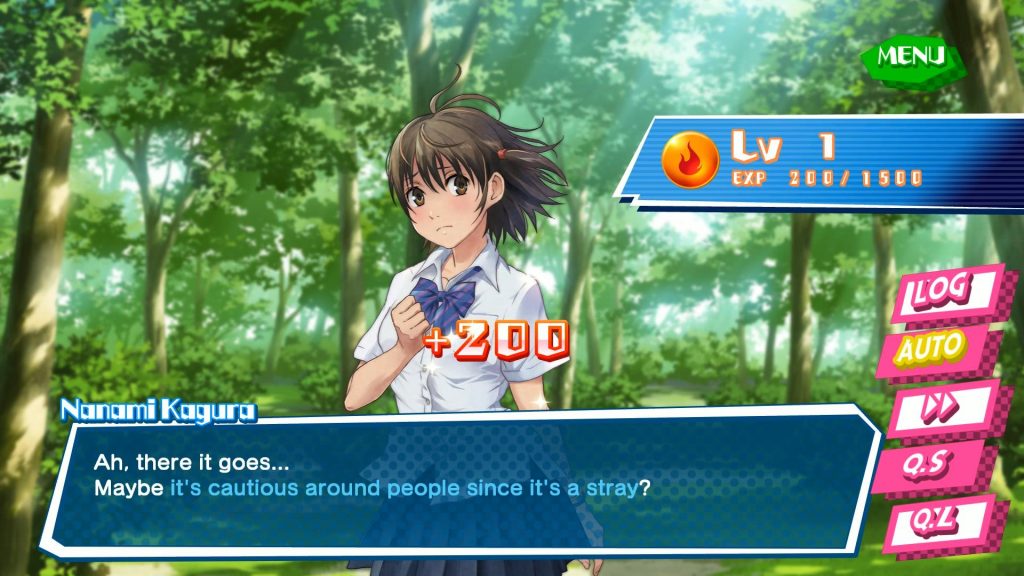Kotodama: The 7 Mysteries of Fujisawa
Developer: Art Co.
Publisher: PQube
Platforms: PlayStation 4, PC, Nintendo Switch (Reviewed)
Release Date: Available Now
Price: $39.99 USD – Available Here
Overview
Over the years PQube has really stepped up their localization efforts to bring niche and even bigger Japanese games to English speaking audiences first in Europe and now around the world. Few publishers that localize games such as these tend to dip their toes into actually developing a game but that just so happens to be the case with Kotodama: The 7 Mysteries of Fujisawa. Partnering with Art Co. PQube has brought out a mystery visual novel that is far more than it initially appears to be and perhaps a sign that more risks like this should be taken.
Story
Without much backstory players find themselves transferring into a new school called the Fujisawa Academy in the middle of the year. The player, whose gender and name is chosen at the start of the game, doesn’t really have an explanation as to why they transferred during such an odd time of the year but perhaps “Mon-chan” a demonic female fox that you have formed a pact with hints that it was likely due to you sticking your nose into dangerous situations and attracting the wrong kind of attention.

Being a new student, the player would rather keep their head low for a bit but that quickly flies out the window as the extremely energetic Nanami Kagura is assigned as being your guide around school. As a member of the school’s Occult Research Club (ORC) Nanami is obsessed with the seven mysteries that have grown popular among the students in the massive campus. Dragged along to help investigate these mysteries while under the guise of the tour players quickly learn that while the mysteries may be rather simple, things at Fujisawa are never as simple as they seem. In fact this describes Kotodama: The 7 Mysteries of Fujisawa as a whole as a visual novel since the first time through the chapters things feel incredibly rushed and very little feels resolved until the big twist is revealed.
One can certainly applaud how much of a facade Kotodama: The 7 Mysteries of Fujisawa manages to hold up until this point in the game and while we won’t say exactly what happened, players will certainly be in for more of a story than they ever could have expected and that the fantasy elements of the game take a major upswing past this point. What may seem like a generic mystery that ends up feeling like players only scratch the surface of issues eventually turns into a one that is almost a bit too complicated for its own good as more mysteries are unveiled in subsequent run throughs.

Players will find that the game’s mysteries will be peeled away layer by layer, a running theme in the game, as they make their way through subsequent runs of the game as it is completely impossible to actually obtain the true ending in one playthrough. In fact, thanks to the aforementioned twist players will be finding themselves exploring the story multiple times over trying to find the best choices to unveil the truth behind the mysteries that may appear simple at first only for the numerous twists to throw players for a loop the more they learn.
Unfortunately despite successfully being able to tell a dark mystery with numerous twists that will keep players enthralled, Kotodama: The 7 Mysteries of Fujisawa does feel like it does a rather poor job actually sticking the landing. Both the normal good ending and especially the true ending will leave players staring at the true credits wondering when the next scene might pop up as the story is ripe to continue in the future. Of course this type of cliffhanger does leave players open to see a sequel or expansion of sorts but be prepared for a mostly dissatisfying ending until then.
Gameplay
Unlike many other visual novels Kotodama: The 7 Mysteries of Fujisawa features quite a few different mechanics that may not feel nearly as important as they are. While playing through the game there are moments that the player has free access to explore various parts of the school and despite initially appearing to be a consequence free system, there are certain events that only end up being triggered when some locations are visited before others. Along those same lines, the “Quacker” style app that the students use to talk online also can play a significant role in unlocking new scenes as well so players will want to keep an eye on that.

Of course the biggest aspect of actually playing in this visual novel outside of making choices happens to be the match-3 puzzle mini-game. Through the player’s pact with the fox demon it is possible for them to make it so they cannot tell them a lie, this is done by enveloping them in a mind-space and playing a mini-game that strips away their lies. Of course to help bring a bit of fan-service to the game, these lies are represented as being layers of clothing so both your female and male targets end up being stripped down to their underwear as a result.
The game is played by selecting the different colored orbs and using a move to slide it to the top of the board in an effort to match three or more of the same color with each target having a specific colored orb that fills up their “Happy” gauge more than others. The goal is to fill this happy gauge fully without running out of moves and facing a game over though every time a layer of clothing is stripped away, which is every fourth of the gauge, ten extra moves are added to the player’s pool. To make things a bit easier players can also use challenge items that have a percentage change to succeed in giving players an extra move or two but risk failing and having to worry about their current board being wiped or the target being shielded from “happy” damage for a bit.

Initially players will find that this mini-game is a bit simple and won’t find much challenge but as the game progresses they will find the game growing much more difficult. While it is possible to increase the damage of some orbs by finding specific “words” in the world there are some stages that are incredibly difficult to finish at times. It is also worth noting that while players have the option to fast-forward past previously read dialogue on a repeat playthrough, it is impossible to skip through a mini-game. This makes the multiple playthroughs a bit more of a drag than they should be since, while the mini-game is fun for a while, it doesn’t really hold up too long when forced multiple times to see the same truth revealed.
Visuals & Audio
The character models in the game are quite gorgeous though players may be a bit disappointed that, since the game is set entirely in the school, that there really isn’t much variety in the actual clothing. The character artwork is fairly unique enough though between the core cast to tell each other apart and the fan service elements are handled even handedly across both female and male characters being stripped down with a number of variants of underwear for all of the characters. It is a bit disappointing to say that while the artwork is great, the actual number of CGs in the game is shockingly small and the background environments themselves are also incredibly generic outside of one or two locations.

The same can be said about the soundtrack for the game as most of the music rarely stands out, though the voice acting is handled incredibly well. That being said, considering the amount of moans that come from the mini-game this may not be one to play too loudly if you’re out and about with the Switch.
Overall
Kotodama: The 7 Mysteries of Fujisawa makes for an enthralling visual novel that may seem simple at the start but once the layers are peeled away (just like the clothing of the characters) the more mysterious and twisted the truth behind the school and the mysteries themselves end up being. By throwing players for a loop and offering a solid storyline that unfortunately doesn’t quite stick the landing, PQube’s first try of publishing a game is a worthy effort for those looking for something unexpected.
Capsule Computers review guidelines can be found here.


